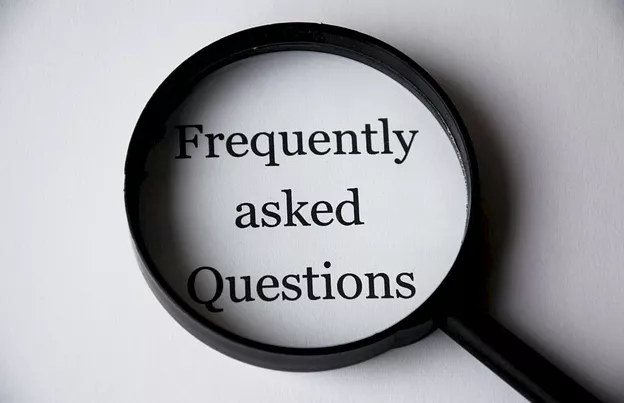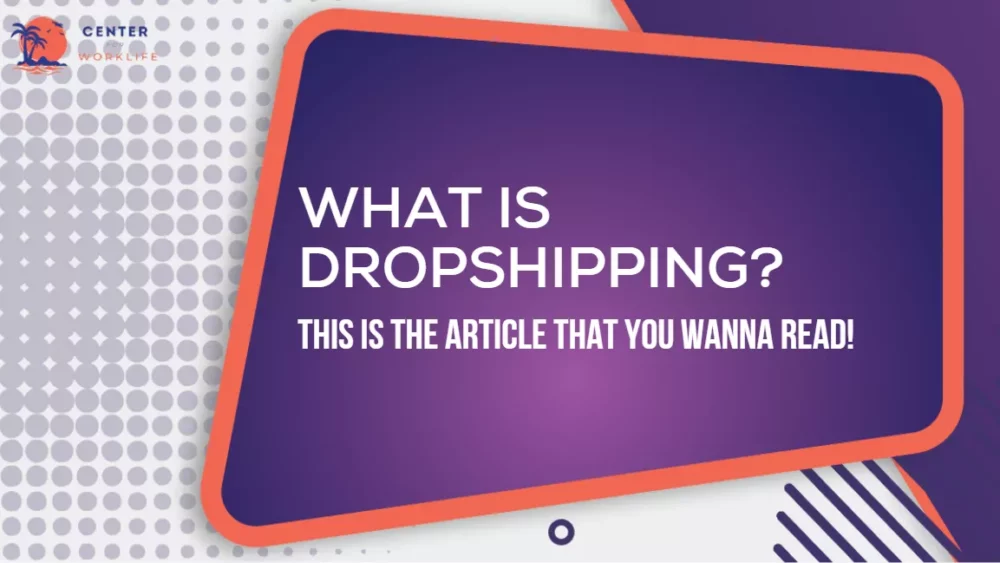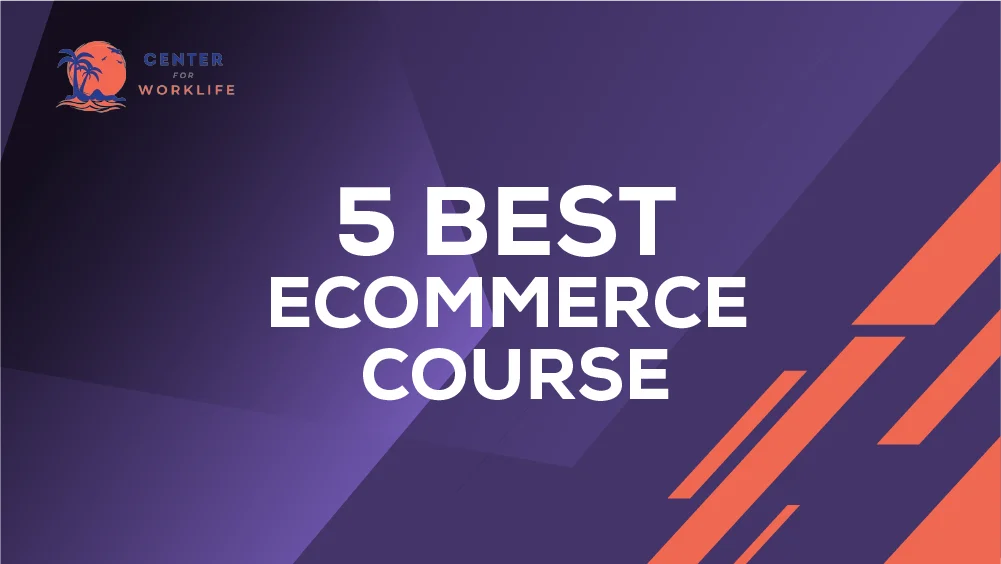What is Dropshipping?
The first step of learning about dropshipping has got to be defining it. So, what is dropshipping?
Dropshipping is a business model that allows a company to sell products without inventory management. Instead, when a customer orders, the company selling the product orders it from a third-party supplier and then has it shipped directly to them.
In essence, the company simply acts as a middleman as it facilitates the transaction between the supplier and buyer without having to deal with the product.
Here’s a simple visual analogy to help paint a clear picture.
Imagine you’re a curator for an art gallery. But instead of buying all the artwork yourself and keeping it in storage, you work with lots of different artists.
When someone wants to buy a painting from your gallery, you don’t have to worry about having it in stock. Instead, you tell the artist who made that painting, and they send it directly to the person who bought it.
You handle the transaction and customer service, but the artists manage the actual inventory and shipping logistics. This way, you can showcase a diverse range of artwork without the overhead of maintaining a large inventory.
That’s kind of how dropshipping works for online stores. They can sell all kinds of things without having to worry about stocking them or shipping them out.
Now that you know what dropshipping is all about, let’s take a look at the key players in this business model.
Key Players of The Dropshipping Business

Let’s unpack the responsibilities of the key players in the dropshipping business model.
Seller Of Record
The dropshipping business always starts with the seller. As the seller, your main responsibility is to put products up for sale, thus enabling customers to find them.
You set the price, record the purchase, and assume responsibility for the sales tax on that particular product. Even if the product comes from a third party, as the seller of record, you still own it before shipping it to the customer.
Manufacturers
The role of manufacturers in this business model is to make products to sell to retailers and wholesalers. While you can purchase the products directly from manufacturers, the amount required to buy them in bulk could be a barrier.
However, there are manufacturers who may offer dropshipping services.
Wholesalers
Wholesalers buy from manufacturers and then sell to retailers at a slightly higher price. They function as middlemen between manufacturers and retailers.
They also don’t sell to consumers, but they may offer dropshipping services to retailers.
If you want to still know more here’s a table that highlights the difference between the three parties.
| Aspect | Seller Of Record | Manufacturers | Wholesalers |
|---|---|---|---|
| Responsibility | Handles sales, customer service, and order fulfillment. | Produces the goods. | Sells products in bulk to retailers or sellers. |
| Ownership | Owns the sales process and customer relationships. | Creates and owns the product. | Owns the inventory and sells to retailers. |
| Inventory | Does not hold inventory; products are shipped directly from manufacturers or wholesalers to customers. | Holds inventory of the products they produce. | Holds inventory of products in bulk for distribution. |
| Risk | Bears the risk of product quality, shipping delays, and customer satisfaction. | Bears the risk of product quality and manufacturing issues. | Bears the risk of holding excess inventory and fluctuations in demand. |
| Profit Margin | Can have higher profit margins due to direct sales to customers without inventory costs. | May have lower profit margins due to production costs and overhead. | May have lower profit margins due to selling products in bulk at wholesale prices. |
How To Start a Dropshipping Business

Now that you know who the key players are in the dropshipping business, the next step is to get your idea off the ground.
So, here’s everything you need to know about how to start dropshipping.
Have a Business Concept
A business concept is simply an idea that describes what you’re selling and to whom you’re selling it. You’ll also need to decide whether you’re the wholesaler or the retailer.
Understanding which key role you’ll play in the dropshipping business helps make it a lot easier to choose the right products.
For instance, you can develop a business concept that says you’ll sell bakeware to home bakers. The products you sell could be something most homebakers haven’t seen in stores near them.
Or you could opt to sell everyday bakeware at an affordable price. Having a general concept of your business helps you know which role you’ll play.
Source Products
Now that you know what role you’ll be playing, whether wholesaler or retailer and what products you’ll sell, the next step is sourcing the products.
Take your time, and don’t rush into building your products. Remember, these are the products you’re selling, which means you have no business without them.
If your goal is to find affordable products, look for wholesalers with the best price ranges.
Some popular marketplaces are:
- Wholesale Central
- AliExpress
- SaleHoo
- Megagoods
- Doba
But if you’re looking for something different from the regular products you see, you could try print-on-demand. This could be anything from books and apparel to home goods like cups or mugs.
Even if your goal is to make money with every sale, ensure you choose products that excite your target audience. Market research will help you determine what items are popular and what products have a high-profit rate.
If you aren’t quite sure, you can always ask your supplier. Most suppliers have been known to provide stats for popular items, which allows you to go for products that actually sell.
Select Your Suppliers

Once you find products you want to sell, the next step is selecting your suppliers. You’ll need to consider several factors to find the right ones.
These factors include:
Quality
Go for a supplier that provides you with the type of quality products you’d want to sell. One strategy for making money with this business model is increasing the price for quality goods, especially if you want to have great profit margins.
But you can also be the discount king of low-quality goods. It’s up to you to choose how you want to portray your business.
Profitable
The whole point of starting a dropshipping business is to make money, so it would only make sense to choose a supplier with profitable products.
Aside from going to a wholesale price for your goods, ensure that what you sell can get you at least 15% to 20% of profits.
Reliability
No business owner wants to tell their customers that products are constantly unaffordable. This is why you’ll need to consider your suppliers’ reliability before doing business with them. You can test out your supplier’s reliability by ordering a few products and checking out their order fulfillment process.
This will give you a general idea of which dropshipping suppliers to cut out and which dropshipping suppliers to engage with.
Return Policy
If possible, find a dropshipping supplier with a refund policy. Most dropshipping suppliers don’t have this measure in place, so you’ll need to check on this before deciding to stock your store with the products.
You could also use the supplier’s refund policy to set up one for your store.
Finding a direct dropshipping supplier is possible, but you’ll need to put in the extra work if you want your business to grow.
Set Up Your Online Store
Now that you finally have your products, the next step is setting up your online store/ e-commerce store. So, what’s an ecommerce store?
An ecommerce store is a site that helps you display products for sale in a pleasing way, all while possessing the shopping carts required to run purchase transactions.
As a newbie, building an online store can be slightly tricky, as there are plenty of moving parts.
For you to build an online store, you’ll need:
- A content management system (CMS) like WordPress, Squarespace, or Shopify
- A domain name for your website
- Web hosting
- Integration with your chosen dropshippers
- An in-built payment gateway for online transactions.
But if building one yourself isn’t possible, there are experts you can contact to help you develop one. There are also several automation services available that can make your entire business process much easier for all parties involved.
Register Your Business
Once your ecommerce store is up and running, you’ll need to separate it from your personal assets. This means creating a name—usually the domain name you’ve used—and filing for a corporation or an LLC.
After successfully submitting your online application, you’ll get a tax identification number (TIN) from the IRS. You’ll use the TIN to open a bank account you can link directly to your payment gateway.
Market Your Business
With everything else in place, it’s time to let others know that you have a business. And the best way you can do that is by marketing your business through social media channels.
You could join social media groups that are relevant to what you’re selling and contribute productively. Don’t try to sell your products by force. Become the group expert, and people will look for your business.
There’s also the option of having social pages on Facebook, TikTok, and Instagram. With these pages, you can post regularly about new products, industry tips and tricks, and various discounts.
Aside from social media pages, you’ll need to invest in ads. That’s either Facebook or Google ads. But make sure you know what you’re doing with these ads, as you could easily flush money down the drain.
Now that you finally know how to start a dropshipping business and how to make money dropshipping, let’s take a look at how to dropship successfully.
How To Dropship Successfully

Starting a dropshipping business is really easy, but that doesn’t mean it will be successful. So, what does it take to be successful?
Well, here are a few tips I think would help.
Go For a Profitable Niche
There’s no point buying products for your dropshipping business if no one will buy them. The best way to guarantee that you sell products is to enter a profitable niche.
However, that isn’t as easy as it sounds, and as such, you’ll need to do market research. Here’s how:
- Look for social trends: Instagram, TikTok, or X can provide useful insights into current hot products.
- Use research tools: There are tools in place that can help you identify trends based on the views they receive every month.
- Browse marketplaces: You can use marketplaces like Amazon, Etsy, or eBay to find a niche of products that sell best.
Tip: If the niche is overpopulated, selling the products might be a challenge. If it’s not known, finding customers for your products will also be a challenge. So, try to go for a niche that isn’t too overpopulated or unknown; that way, you can sell your products.
Provide Value
Finding the right products is only half the battle; you’ll still need to provide value to your potential customers.
This will help your business stand out from other dropshipping businesses. One way to provide unique value to your customers is through branded drop shipping.
You could create personalized products catering to your target customer needs. There’s also the option of having an online community bound by interests and values.
This will help build a stronger brand and increase your sales.
Choose the Best Platform to Sell On
The platform you decide to sell on is just as important as the products you choose. Every sales channel is different, with its own capabilities, features, and limitations.
If your drop shipping business is going to succeed, you’ll need to find a platform that best suits your online business.
So, when choosing a platform, consider your niche, target audience, and personal preferences.
For this, there are two options: an Ecommerce platform or an ecommerce marketplace.
An e-commerce platform allows entrepreneurs to build their own stores and sell online. These platforms are also easy to customize, offer a variety of useful features, and provide great customer control. Examples of these platforms include:
- Wix
- BigCommerce
- Dropshipping with Shopify
- Squarespace and more
Ecommerce marketplaces, on the other hand, host ecommerce stores on a single platform. It’s like an online shopping center with multiple stores.
They are beginner-friendly and easy to set up. But it’s important to note that you don’t have any control over the design and content of the store.
Examples of ecommerce marketplaces include:
- Walmart
- Etsy
- Ebay
If you still want to learn more about the difference between ecommerce marketplaces and platforms, here’s a table that clearly details that.
| Feature | E-commerce Platform | E-commerce Marketplace |
|---|---|---|
| Ownership | A single entity owns and manages the platform, but you can own a store. | Multiple sellers/vendors operate on the same platform. |
| Inventory Management | Sellers manage their own inventory. | Centralized inventory management system. |
| Product Offering | Typically, the platform owner sells products directly or acts as a distributor. | Wide range of products offered by various sellers. |
| Seller Control | Limited control over sellers’ operations. | Sellers have control over their operations within platform guidelines. |
| Branding Control | The store owner has complete control over branding. | Sellers maintain their own branding within platform guidelines. |
| Revenue Model | Revenue generated from product sales, subscription fees, transaction fees, etc. | Revenue from commissions on sales, listing fees, and sometimes subscription fees. |
| Customer Service | The store owner handles customer service. | Each seller may handle their own customer service or rely on platform support. |
| Competition | Competes with other platforms and marketplaces. | Competes with other sellers on the same marketplace. |
| Scalability | Usually easier to scale as it’s under one entity’s control. | Scaling can be challenging. |
Focus on Marketing and SEO
Things have really changed nowadays, right? Gone are the days when a simple chat over the fence could do wonders for your business. Nope, in this digital age, if you’re running an online store, you’ve got to cozy up to the internet.
But hold up, it’s not just about having an internet connection anymore.
And it’s more than simply having an internet connection; it’s about making use of SEO and digital marketing strategies.
Let’s talk about some simple strategies to help your drop shipping business grow:
- Email marketing: It’s like sending out cool emails instead of flyers.
- Social media marketing: Yup, you can actually use Instagram and other platforms to promote your business.
- SEO: This is about making sure your website shows up higher in Google searches.
- Content marketing: Think of it like creating fun blog posts or videos to attract people to your business.
Each of these strategies works if you know exactly what you’re doing. Now, if all this sounds a bit overwhelming, don’t worry! There’s a program called the Digital Rental Method that can teach you everything you need to know about SEO and social media marketing.
And here’s the best part: Once you’ve got these skills, you can do more than just drop shipping. You can start an online business with these skills that earn you anywhere from $2,000 to $10,000 every month.
Believe me, that’s a whole lot more than what dropshipping alone can offer. But hey, don’t just take my word for it. Continue reading and see for yourself.
Customer Experience
The last tip to building a successful ecommerce business is to have the best customer experience. Remember, your customers are the most important link in your entire business.
Without them, you won’t be able to make money, as no one will buy your products. So, try to keep them as happy as possible.
If they are happy, they’re more likely to suggest your business to others and buy more. Here are a few tips on how to keep them happy.
- Answer their inquiries and questions politely. Very few dropshipping companies have a great customer experience. Having one that answers and addresses your customers’ concerns politely will help you stand out.
- Social proof: Customers want to see what other people think of your products. In fact, 60% of consumers decide on whether to buy products depending on the available reviews.
Taking these actions, however small, can really help your ecommerce business grow.
Is Dropshipping A Good Side Hustle?

It’s finally time to answer the question you’ve probably had since the start of this article: Is dropshipping a good side hustle?
My answer is no. I’m not downplaying the fact that there have been plenty of successful dropshipping businesses.
But, the risks outweigh the benefits of dropshipping. Let me explain in detail why I said this:
Competition
One of the biggest hurdles dropshipping businesses face every year is the threat of competition. While one could argue that’s something every business faces, when it comes to dropshipping, this challenge is slightly bigger.
There’s more competition today than there was when dropshipping first started. And while more ecommerce businesses pop up, the demand remains the same.
According to a recent report, drop shipping only fulfills 23% of online sales. That’s a small market to cover. Imagine trying to get a piece of that small pie when there are millions of other stores just like yours!
You’ve got to do everything you can to make your store stand out. That means spending money on ads, keeping your prices low, and sometimes even asking friends to write good reviews.
It’s tough out there, which is why lots of these online stores end up closing down after just three months.
Low-Profit Margins
The entire reason we start businesses is to make money, and that’s no exception for drop shipping businesses. But the reality is dropshipping doesn’t come with great profit margins.
Now, before we get into why, let’s answer a simple question: How much does it cost to start dropshipping?
It could be a few thousand dollars, depending on things like setting up your website. The good part is that you don’t have to buy products upfront because your supplier handles all that.
But there’s a catch – you’re kind of at the mercy of your suppliers. You can’t control the prices, which makes it hard to compete. Plus, cutting prices means making less money, especially if you work with different suppliers.
And your income can be all over the place. Some months, you’re doing great; other months, not so much.
If you’re looking to create a consistent semi-passive income, I suggest the Digital Rental Method.
The Digital Rental Method is a program that shows you how to build a lasting and expandable business using digital marketing tactics.
And the cherry on top? You’re not just making money for yourself—you’re also helping local businesses thrive. Much better than the uncertainty of dropshipping, right?
You Have Zero Control
While starting a dropshipping business doesn’t require much when it comes to inventory management, that is however, an advantage and a disadvantage.
It’s an advantage because you don’t have to spend thousands buying products. On the flip side, it’s a disadvantage because you have zero control of your business.
All you do is handle customer orders, which leaves you vulnerable to aspects beyond your control, like supply chain issues, product quality, and shipping times.
So, if your supplier experiences low stock or delays, you will as well, which can eventually result in your business closing down.
Traffic
Research indicates that approximately 62% of Shopify stores call the U.S. home. That’s a whopping 875,000 stores just in the U.S. alone, vying for attention. And guess what? The number keeps on climbing.
With this surge in online stores, it’s crystal clear you’re entering a fierce competition to win over loyal customers. To stand out, it’s crucial to invest in top-notch social ads, killer content, and other savvy digital marketing strategies.
Now, here’s the kicker: You can’t just copy-paste what everyone else is doing and hope for the best. Nope, you need to up your digital marketing game.
That’s where the Digital Rental Method swoops in to save the day.
Sure, some of the best dropshipping courses touch on these skills, but nothing quite matches the power of the Digital Rental Method.
With this method, you’ll dive deep into the world of digital marketing, mastering everything from social media wizardry to SEO sorcery. Once you’ve got these skills under your belt, you’ll be equipped to build a business that’s not just another dropshipping venture.
Picture this: a sustainable business where you’re not constantly sweating over traffic or drowning in competition. Yep, there’s plenty of cake to go around, and with the Digital Rental Method, you’re getting a big slice.
Finding New Products
What’s new today might not be a trend tomorrow. Think about fidget spinners. Remember those? Five years ago, everyone, from little kids to grandparents, was crazy about them. But now? Not so much.
Fast forward to today, and you’d be hard-pressed to find someone who even remembers where their fidget spinner ended up. Yep, that spinning gadget is a prime example of how trends come and go, and it’s something to keep in mind for your drop shipping business.
According to a recent study, most products only stay hot for about 60 days. That means you’ve got a pretty narrow window to hop on the next big thing.
That in itself is going to always be an uphill battle since you’ll always be starting from scratch. You could also end up entirely missing out on products that might actually sell.
Platform Bans
Aside from the ecommerce platform, dropshippers depend on different platforms like Facebook to market their products to reach a wider audience.
However, these platforms do have measures in place that could end up banning a dropshipping business from selling its products. Stats show that Facebook alone has banned over 67.74% of users for content violations.
Also, several ecommerce platforms have strict regulations you need to adhere to if you want to continue earning with their site.
Being banned from any platform can shut down your business, which is bad, especially if dropshipping is your side hustle.
Complex Shipping
If you work with multiple suppliers, calculating your shipping fees could be complicated, as more than one supplier will fulfill orders.
You could end up paying more than what’s required. This would mean an even lower profit margin for the sales you make.
I could go on, and on about dropshipping risks, but at the end of the day, you’ve got to decide whether it’s worth it or whether there are other business models you can pursue to generate the income you desire.
But before I show you my number #1 way to make money online, let me first answer some of the frequently asked questions about dropshipping.
FAQS

Some of the most common FAQs on dropshipping include:
Is Dropshipping Legitimate?
So, is dropshipping legitimate? Yes, it is. But does that mean it’s lucrative? No. Dropshipping is like any other business; the only difference is that you’re basically outsourcing everything apart from marketing.
That’s something this Reddit thread clearly highlights. There’s a lot that you’ll have to handle, especially with marketing and shipping that could end up leaving you in debt.
Even if dropshipping is legit, you need to make sure you don’t fall into any of the dropshipping scams, as they do come in a lot of forms.
So, how do you identify if there’s a dropshipping scam?
You could look at the following aspects:
- Fake products
- Phony product samples
- Fake reviews and samples
- Get-rich-quick schemes
- Fraudulent payments
Is Dropshipping Worth It?
So, is dropshipping worth it? No, it isn’t. If you’re looking to create a consistent and reliable semi-passive income, dropshipping might not be the way to go.
There are several aspects that can actually make running a dropshipping business even more difficult. These aspects include:
- High costs of goods
- Refund
- Lack of proper customer support
- Low product quality
- Unprofessionalism
Why Do Dropshippers Fail?
Even if you do choose to start a dropshipping business, you’ll still need to know why do dropshippers fail. So, how How difficult is dropshipping? Close to 90% of dropshippers close their businesses by the third month.
Learning why this happens makes a huge difference in the fate of your business. So, why do these businesses fail? They:
Fail To Vet Their Suppliers
Suppliers are an important part of the supply chain. The supplier you choose can make or break your entire business.
Failing to vet your suppliers can lead to unfulfilled orders, which eventually leads to unhappy customers. When your customers are angry, your business won’t thrive.
Not Marketing Your Store
Your main responsibility in running a drop shipping business is marketing. If you don’t know how to use digital marketing, it’s going to be difficult to sell your products.
Stats do, in fact, show that close to 71% of sales on ecommerce sites happen because of social media. So, it makes actual sense to learn how to market your stores.
This is why you should choose a program that actually shows you how to use social media marketing and SEO. That program is the Digital Rental Method.
What’s My Number #1 Way To Make Money Online in 2024?

I’ve personally tried all of the major online business models:
- I’ve drop-shipped a toilet bowl putting green on Shopify
- I’ve drop-shipped jade rollers via Clickfunnels
- I’ve sold fidget spinners through Amazon FBA
- I’ve sold women’s health supplements via Clickbank affiliate marketing
And I made money with all of them, so trust me when I say: there is no “perfect” business model.
That being said, my #1 recommendation for making real money online is, hands-down: being the Digital Rental Method.
Whether you’re a complete newbie, or you’ve been around the block before but have never had that “big win” to propel you forward, the Digital Rental Method is for you.
Why?
1)Time: If you’ve got a spare hour-or-two each day, you can do this. If you want to drop everything and go all-in, you can do this. More time obviously means faster results, but even putting in a few hours per day is enough to see real success.
And because of that flexibility, you don’t need to trade your time for money. Once the income starts, it’s recurring.
That means you can take a month off, travel the country, pursue a passion project, chill on the beach, or charter a boat across the world.
But you can only do that once you’ve created an income stream that doesn’t require YOU to be there all day, every day.
2)Ownership & Control: With dropshipping, you don’t actually own anything. You can’t control your product quality, or even what the package looks like when it shows up.
Technically you own your Shopify site… but ad platforms could shut you down on a moment’s notice… so you don’t really have much control there.
Why pour your soul into a business that could be taken away from you at the drop of a dime?
With the Digital Rental Method, you literally own all of the assets, which means you have ultimate control.
3)Fulfillment: Alright, so you don’t have any inventory… but that worry has been replaced with the pains of overseas fulfillment.
That means your customer is going to have to wait 3-4 weeks to receive their order.
Then add in the current global supply chain woes… and you’re looking at 5-6-7 weeks!
Then the customer slaps you with a refund, and all of that time spent testing and spending money on ads was for nothing.
You don’t have to worry about any of that when you’re renting out digital properties.
4) It’s Effectively Copy-Paste: Here’s my favorite part: once you have your first Digital Rental Property up, you can literally copy-paste another version of it and find another willing “renter” in a few days. DOUBLING your income doesn’t get much easier than that…
If you wanted to double your income with dropshipping, you would need to sell twice as much inventory, or double your profit margins. And I can guarantee you (from my shopify dropshipping days), that’s a lot harder than a few clicks & a phone call.
5) Big Margins: With dropshipping, you’re often going to have really slim margins. That means you need to hit a serious scale to make serious money. This usually entails spending A LOT of money on ads and other methods for growing traffic to your product.
In the Digital Rental Method, your profit margin is nearly 100%. Watch here to learn how.
Just a reminder: these Digital Rental Properties are worth (at a minimum) $500/mo in semi-passive income. And each time you create another one, your income increases, and the effort put into creating the next property decreases.
Best case scenario, you have properties bringing in over $3,000+/mo on auto-pilot.
6) You’re Helping REAL People: My biggest gripe with dropshipping is that you’re usually finding some product that’s complete garbage, and are tricking people into buying it. It provides no real value to them, or to the world in general.
It’s cool in the short term to make a quick buck, but in the long-term, it gets really old, really fast.
But when you’re talking about the Digital Rental Method, you’re helping solve REAL problems that people are ASKING for help with.
Small local businesses around the world need one thing: customers. Without them, their business would fall apart. If we can provide those customers, they’re going to be really happy – and they’re going to pay you for it.
You’re helping a struggling mother or father put FOOD on the table for their families, put their kids through college, or simply live life a little bit more comfortably.
Having this type of impact on the world is what will help you sleep soundly at night.
So, the rest is up to you. You could keep looking at other dropshipping programs, which might make you money 12 months from now.
OR, you can look deep inside, think about those dreams, hopes, & desires, and make the decision to ACTUALLY make it happen, just like it has for thousands of other students before you.
Making a fortune while actually helping real people that need it.
If this sounds like you, click here to see how it all works.





